It’s hard to write anything now—an obvious statement. The world feels heavy with news. I’ve been prepping a lesson plan on place, with a focus on ecopoetry—how we can locate the human, the self, and where we are within the world. An eye on resources—how that awareness toward what we’re losing is creeping into our work. The slight glint toward elegy.
And yet, there is also a reach toward praise: Don’t we still have things to love? Don’t we still yearn for comfort and joy? It’s hard to even ask and consider in times like this. I am grateful for the bread at my table when many tables have been demolished. (I just read Mosab Abu Toha’s “The View from My Window in Gaza,” where he went back to his apartment for bread as more bombs fall.)
In this heaviness, I find moments to look toward the East. Doctors Without Borders is providing aid, and if you are moved to do so, please send a donation.
In this heaviness, I think back on some of the brightnesses allotted in my small life: like the brightness of discovery, of a true test, at Sagaponack. Sagaponack is named after a town in the Hamptons—I’ve never been, but have dreamed of the area often. (Yes, while watching the Real Housewives of New York go there for their summer fun—and let’s not forget the winter Christmas sleepover of yore.) It’s also an area I dream of often, as my beloved was out there for work the day before we went on our first date. How chic, I thought. And little did I know that, four years later, we would have a twist on the tastes of the town in the Flatiron District.
Sagaponack focuses on quality seafood, melding Asian and Mediterranean flavors. The menu is succinct—it’s focused, not cumbersome to navigate. And incredibly affordable. No dish is over $40, which makes it welcoming for many budgets—and can help pave the path for enjoying an oyster or two.
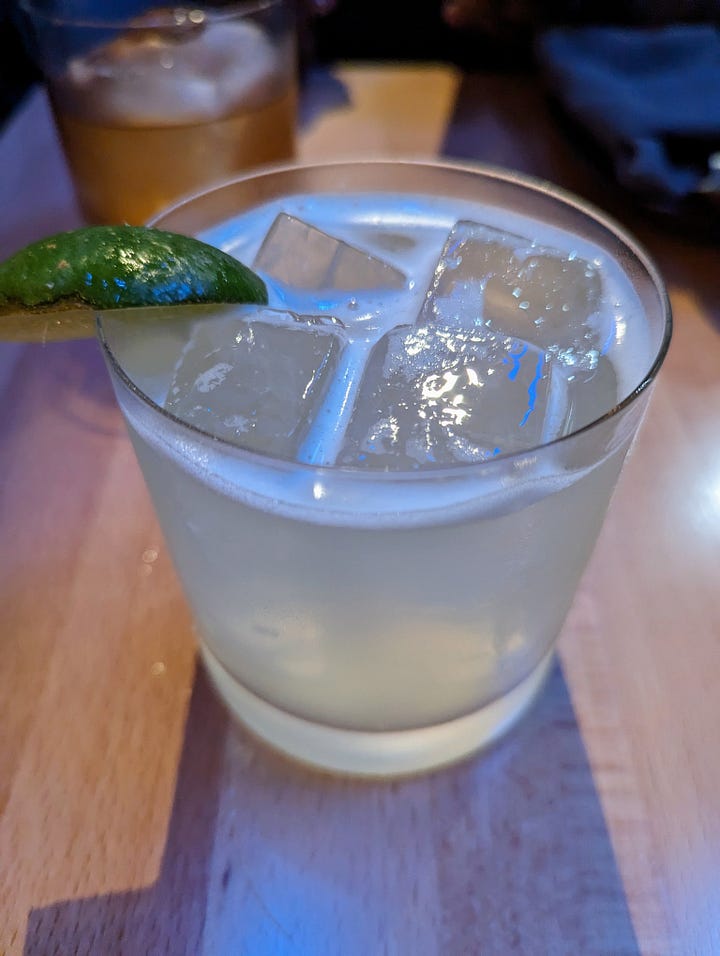
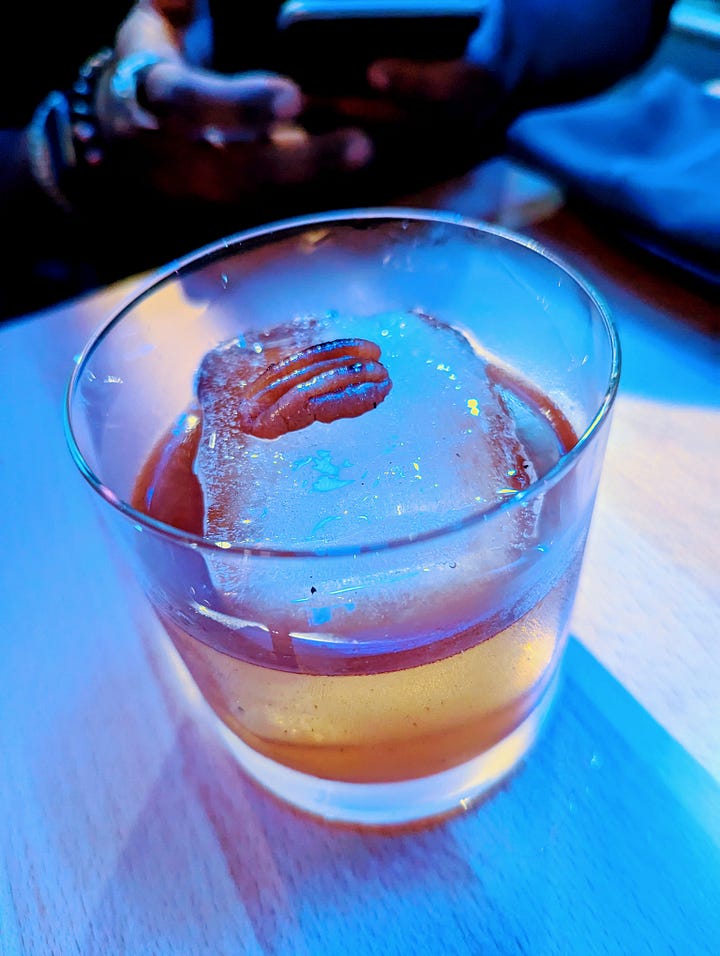
We had just dipped into fall. I still wanted a touch of summer, so I chose a Harana—a gin and tonic spiced with Thai chili and ginger, brightened by cucumber and lime. My beloved had the very first (seriously, the mixologist told us it was the first one anyone had at the restaurant) Pecan Pie Old Fashioned—bourbon, walnut bitters, and toasted pecan syrup with a candied pecan as garnish. Both were perfect starts to bridge our way between seasons—and soon, to the food.
We told the restaurant we didn’t have any allergies—and while true, we only admitted our hesitancy toward certain items to ourselves. I had a bad reaction to clam chowder in elementary or middle school, a reaction I tested by eating mussels at a buffet a week, then a month later. I learned that I had food aversion, so shied away from clams, oysters, and mussels for years. It was only two years ago, when presented with gleaming clean oysters, a lick of lemon, that I tried again. They went down smooth. I waited 10 minutes, for fear of my stomach vaulting—and it didn’t. It stayed with me, saying, yes, we’re good—do not hesitate in this joy.
But my beloved was, well, skeptical and curious. He hesitated with other foods, but this was the year we deemed “expansion of palate.” So we dove into the dressed oysters in front of us: first, the brightness of yuzu, cucumber and dill. Then the quick heat of Fresno and Serrano chilis, a light hint of shallot. And finally, if the oyster could be put on a pedestal, the caviar—Adamas Siberian caviar topping buttermilk, the oyster tucked under.
We were then offered the roasted versions, with brown butter, tempura flakes, hints of lemon and shoyu. The other, a gochujang butter, with serrano, sesame breadcrumbs and scallions. The butter brought some unctuous delights, especially when it came to comparing the sweet and spicy components of these offerings—the bright brine always coming through.
We broke our oyster diving up with the fluke tartare. Beautiful, the red fish studded with marcona almonds, coconut, and tobiko. The aguachile of coconut and an herby sauce. I could swim in the broth, all those sweet herby notes and texture against the fish.


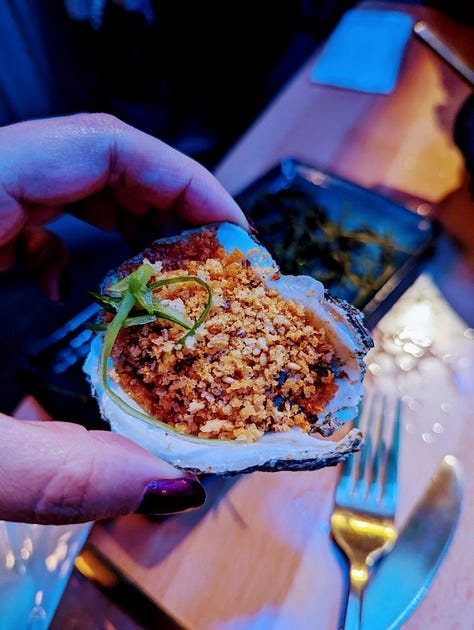
And then, more surprises: the brothy hot fishes.
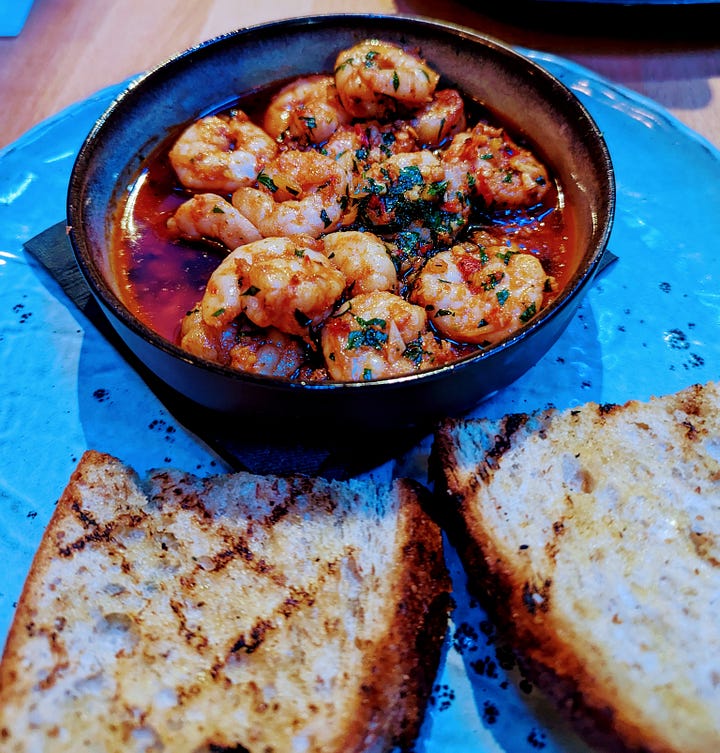
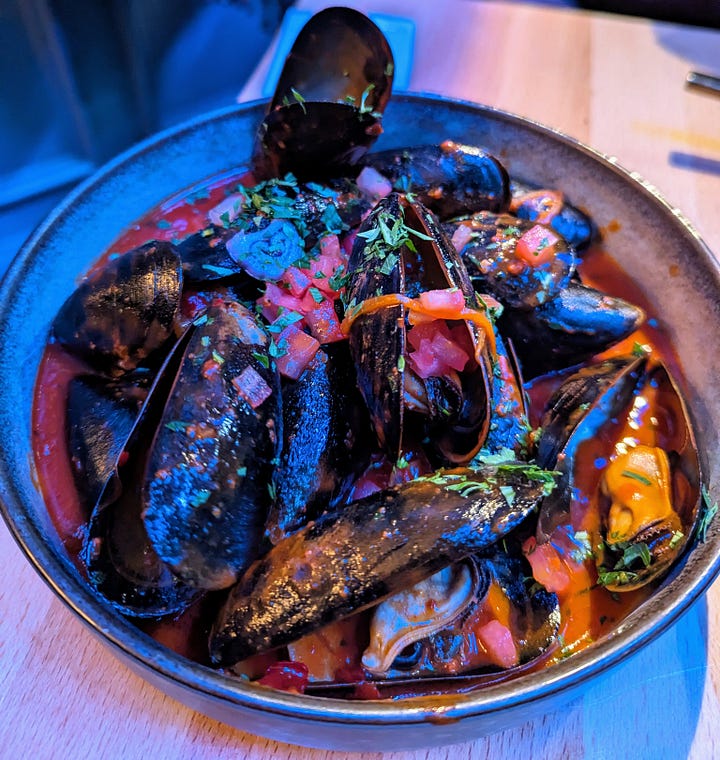
We eyed the Gambas al Ajillo—shrimp with pimento and preserved lemon in a tomato-based broth. The joy of dipping the bread into the broth, soaking it, the slight salt on the bread and char accenting the sweetness of shrimp, the spot of lemon.
And then, the surprise—another test, one I’d longed to try since undergrad and grad school: mussels. And not just any mussels, but ‘Nduja—the broth accented by pork sausag and guajillo and Calabrian chilis. I looked at my beloved, said a prayer to the food gods to give my stomach strength, and ate. I didn’t wait even a minute until I stuck my fork into another shell, tossed it into a pail. And more bread—the sop, the mussel quickly folding into the bite. The acidic pickle onion, the warmth. This was a fall fish dish. There I was, already daydreaming: another cozy night, a glass of something, and this giant bowl of mussels to enjoy.
In the bevy of surprises, we asked for two dishes we saw on the menu: the shoyu salmon, paired with broccolini, jeweled rice, oyster mushrooms, and shoyu butter, and hanger steak with hazelnuts, broccolini, roasted potatoes, and salsa verde.
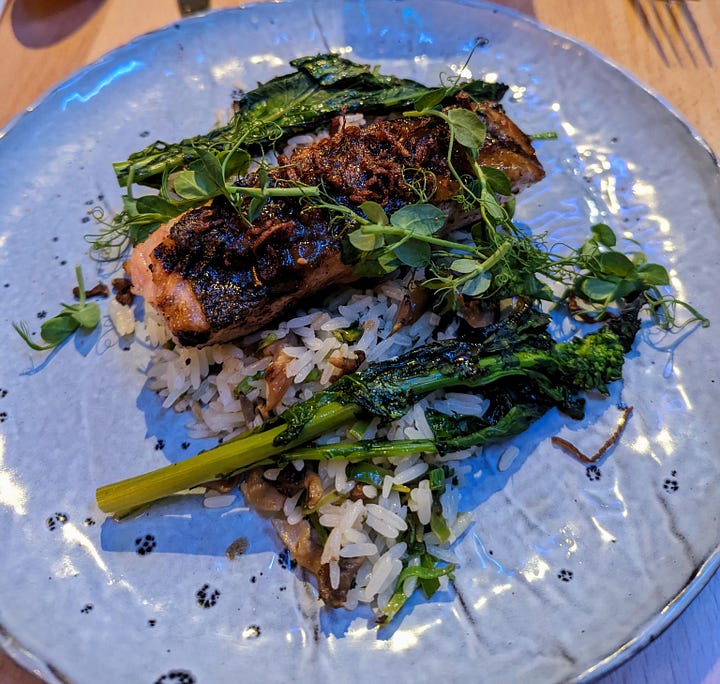
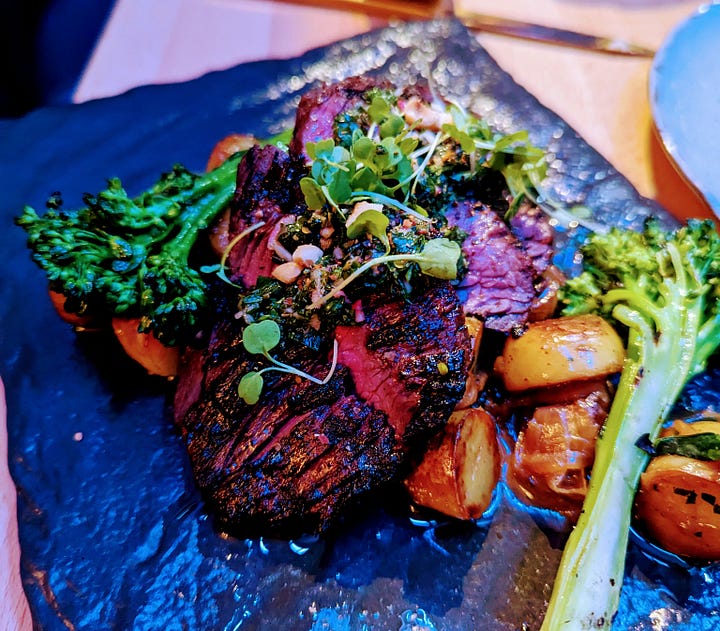
As if salmon could ever be this tender. As if hanger steak could be more perfect in char and cookery. Jumping between the two dishes was a beautiful surf and turf experience, bridged by the accoutrement of broccolini, rice, and potatoes. The salsa verde popped, as expected. The shoyu butter, a layer of richness throughout the salmon and rice.
Somehow, we left room for dessert. We said surprise us, and luckily received the Thai tea milk cake, with a swirl of cinnamon icing, stuffed with cubed mangos, and topped with pecan crumble. It’s a perfect dessert for fall (hello cinnamon and pecans) but the bridge between seasons with the mango, and the everlasting joy of Thai tea cream underneath a beautiful cake.
To be between seasons can feel like a true test—not only of outerwear, but on the emotional and mental capacities. The summer fun energy swings toward cozy fall. The sun peeks out later and later in the morning. The nights lean into a chill. And yet, at Sagaponack, we can have moments of summer freshness—while also leaning toward seasonality (thanks to the cocktails!). We can have the dream of the Hamptons in front of us, all at more affordable prices than the landmark itself. I’ll keep eating at Sagaponack while counting down toward summer. I’ll keep testing and trying the seafood frontier until I’ve eaten the entire menu—then repeat again and again.
And Now, We Further the Plot: Your Literary Rec
Many friends turn to poetry for comfort. I believe poems can find us at the right time—can somehow find their legs and further their journey based on where we are in our lives, what time we live in and encounter them. Often, those poems we find are written many years before us—and yet, they feel like they were written for our moment.
Hala Alyan is one of my favorite poets. I’ve turned to her work countless times, and consider her a bright light and dear friend. She just had this poem, “Naturalized,” published in Jewish Currents this past Friday. Editor Claire Schwartz introduces the poem gorgeously, noting the poem’s eye toward global events, the self critical of their own consumption—and how the world positions and consumes her.
May the poem bring some form of comfort. May it lead to a moment of contemplation, perhaps over the next bite of joy, and how you can also give that joy to others. How we can find moments to hope toward. How, perhaps, we can find moments to give back.




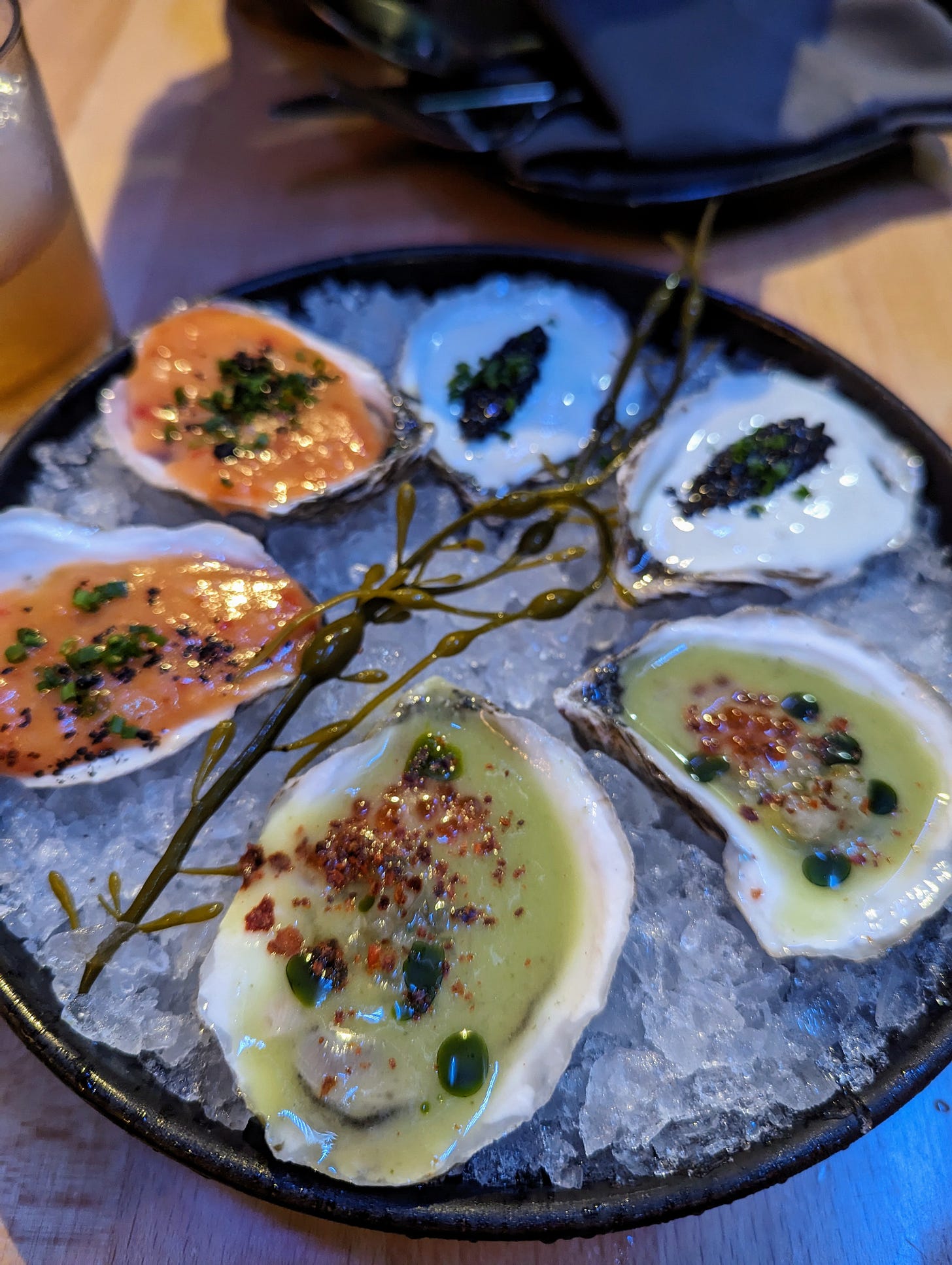

The 'nduja mussels look outrageous. Everything looks amazing. I love the year of expanding the palate!